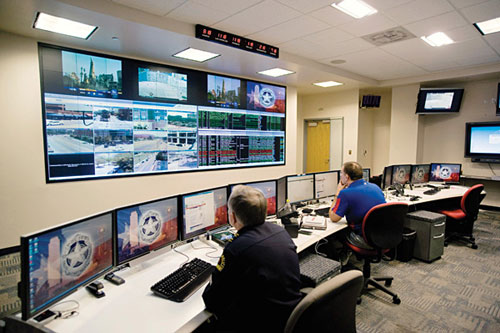Rear-Projection Tiled Digital Media Walls
Seams delineating the separate screen units within a total display configuration are often highly visible among arrays of various digital formats. With the highest resolution LED screens, the gap between each pixel may range from 1 to 3 mm and becomes visible at short distances. With flat panels, the smallest seams between panels are about 6 mm for LCD and 2 mm for plasmas. The seams may be misaligned in the grid, which can distract from the media, and emphasize glare in the corner of a screen.
Compared to LED, flat-panel LCD and plasma screens, rear-projection tiled digital media walls can produce a nearly seamless digital canvas, with seams between the modular units as narrow as 1 mm, and no limit to the number of tiles in a display. As a result, these modular tiled video building blocks can blend into any environment, allowing audiences to focus on the message, and not the medium or the technology.
Content is generally fed to the media wall from a custom cabinet that can be located near the display rack, or in a control or server room within the facility.
 |
The Dallas Police Department Fusion Center gathers and shares intelligence 24/7 with other agencies. Self-calibrating for color and brightness matching, the rear-projection tiled video wall produces high-resolution and superior image quality in high ambient light environments, without glare or reflection. Dallas, Texas. |
Sustainability
Several characteristics impact the sustainable qualities of digital displays, including energy consumption over the entire product life cycle, durability, ergonomics, reusability and recyclability. Some characteristics depend on the project application, while other factors include the costs associated with:
- Manufacturing, installation and servicing a display
- Installing or updating a display with a short life cycle, versus installing a display with a longer life cycle
- Lost productivity and revenues resulting from poor ergonomics
- Relocating or modifying a display within a building during renovations, change of use or new tenants
- Disposal and recycling
 |
Precise color reproduction in the rear-projection digital media wall matches branding and packaging at NYC's Fresh flagship store. |
Energy Consumption
Energy-efficient manufacturing processes can be measured and audited to ensure environmental targets are met. Energy savings can be achieved with rear-projection tiled digital displays because the overall brightness can be adjusted to an appropriate level for the ambient light environment, saving energy and increasing product longevity.
Most tiled flat-panel screens and rear-projection systems offering high resolution and comfortable brightness levels range in efficiency from 0.3 to 1.5 watts per candela. A typical calibrated rear-projection tiled digital display operates at approximately 0.9 watts per candela. A candela is a standard international unit of luminous intensity, that is, power emitted by a light source in a particular direction.
Servicing
Ease of servicing and maintenance is important for facilities with limited staff or locations where trained maintenance crews must travel to the site. Many conventional tiled displays cannot be serviced from the front, or require complex brackets or machinery to expose a panel in the middle or bottom of an array. Newer formats of rear-projection tiled digital display walls can be serviced from the front, by removing the screen, revealing three components that each take less than 15 minutes to replace.
Durability
Rear-projection tiled digital displays use highly reliable and long-lasting LED illumination and DLP® technology, with no consumables or moving parts that require periodic replacement or recalibration.
Ergonomics
Controlling the brightness of a display to suit the environment is important for visibility. Rear-projection tiled digital displays offer ideal levels of controlled brightness for indoor high ambient light environments, and are comfortable for close-up viewing.
Unlike LCD, plasma and surface-mounted LED displays, rear-projection tiled digital displays are cool to the touch and do not radiate heat to the viewer, making them ideal for indoor spaces and touchscreen applications where people are close to the display. Rear-projection tiled digital displays are suitable for noise-sensitive environments, such as broadcast sets and some corporate spaces. Each tile contains two high-efficiency fans, which run only as fast as they need to, keeping noise levels to a minimum.









